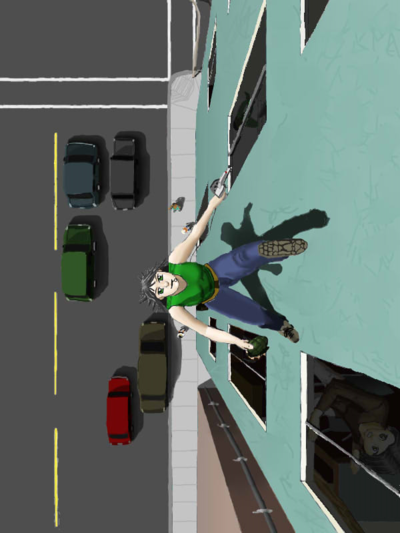Movement

|
Characters can have several movement modes.
Each mode may come with a run option: running makes you some amount faster, but means that you must move at least your normal speed. Running also makes you easier to hear.
If a character would gain a movement speed they already have, they do not add together.
Moving on top of a creature causes you to be riding it. It may force you to hit it with an attack against GD in order to succeed; if you miss, you lose 3 meters of movement, it deals its unarmed damage to you, and you cannot try to ride that creature again this round.
Moving up from underneath a creature causes it to be riding you. It may force you to hit it with an attack against GD in order to succeed; if you miss, you lose 3 meters of movement, it deals its unarmed damage to you, and you cannot try to be ridden by that creature again this round.
It is possible to squeeze through a passage with no dimension narrower than one quarter your size. Doing so makes you move half as quickly, but you can attempt to move at full speed instead by making a DC 5 Agility check; failure ends the movement action at the small space. While in such a small place, you are squeezed.
Land Speed
With a land speed, you must move from place to place without leaving the ground for longer than your jump distance. Jumps upwards count as being twice as far for the purpose of calculating jump distance.
Chandeliers and other hanging objects can be used as jumping spots, so long as you maintain your momentum by jumping from them during the same action you use to jump to them. If you attempt to use any such swinging devices, you must succeed on an Agility check (DC 2 + the number of devices used) or miss and fall prone on the ground below.
Some terrain is difficult to maneuver on, such as loose boulders, slippery ice, or tightropes. Unless you move at half speed over it, you must make a DC 5 Agility check or fall prone. If you try to jump onto or from such difficult terrain, you must succeed at a DC 7 Agility check or fall prone as well.
Walking through water is possible, but you move half as fast, and, without climbing instead, cannot move further downwards in a round than your sink distance sends you.
Running doubles your Land speed, but requires you to move in a straight line.
Climbing

|
Climbing steep surfaces requires you to make Agility checks.
Climbing at half your non-run land speed is DC 5 for surfaces with consistent footholds, or DC 7 without. Climbing at full speed increases the DC by 1. Climbing while running increases the DC by 2. Climbing without devoting at least one hand to the climb increases the DC by 2.
A climbing check lasts for 1 round, plus 1 for every point by which you beat the DC. After this time, you must take a one-round break from climbing, and make a new Agility check if you'd like to resume climbing. If you switch to a more difficult climb, you must make a new check. If you cannot fail a climb check, you can maintain that rate of climb indefinitely without breaks.
Moving With Ropes
Climbing up a rope is just like climbing on a surface with consistent footholds; when moving at half speed, however, two hands are occupied holding onto the rope.
Ropes can be used to swing from one location to another, by following an arc with a radius equal to the length of the rope. It's hard to swing to locations higher than you started from; you can only increase in altitude to a maximum of half your jump distance. This type of movement uses your land speed, and at the end of any action to swing, if you're still on the rope, you find yourself dangling from it.
Burrow Speed
With a burrow speed, you can travel through sand, mud, or dust. Travelling through loose or soft rock (like gravel or sandstone) halves your movement, and hard rock or soft metal (like granite or gold) quarters it. You can't travel through harder metals or minerals (like steel or diamond) at all. If the material is strong enough to support a tunnel, burrowing leaves a tunnel behind you.
Running increases your Burrow speed by 2 meters, but requires you to move in a straight line.
Swim Speed
With a swim speed, you can travel through liquids.
Every creature and object has a Sink Distance, which is 5 meters by default. At the beginning of your turn, you sink that many meters into water (other liquids provide bonuses or penalties to Sink Distance). If your Sink Distance is negative, you float towards the surface instead.
Running increases your Swim speed by 50%, but requires you to move in a straight line.
Fly Speed
A fly speed allows you to travel through gaseous atmospheres. In gases thicker than 1 Atmosphere, your fly speed is divided by the number of Atmospheres of pressure; in gases thinner than 1 Atmosphere, your aerobatics distance is divided by the number of Atmospheres of pressure.
The associated aerobatics distance indicates how awkwardly you fly: it is the shortest distance you can travel laterally for every meter of altitude you gain. In addition, you cannot change direction as easily while flying as while using other movement modes: the smallest distance you can pivot around while flying is equal to your aerobatics distance, and you still have to pivot in order to change direction from one move action to the next. At the end of your turn, if you are airborne and have a fly speed, but did not use it that turn, you move forwards in the direction you last flew a distance equal to twice your aerobatics distance.
Running doubles your Fly speed, but multiplies the radius you can pivot around by 4, and raises it to a minimum of 8 meters.
Teleport Speed
With a teleport speed, you specify a direction and a distance. If there's nothing denser than smoke at that location, you disappear from your current location and appear at that location. If there's an obstacle there, you do not disappear at all. Using a teleport speed is a purely mental action. When you teleport, you bring anything and anyone you are carrying, wearing, or that is tightly bound to you. The teleportation fails if you would bring along enough stuff to make you overloaded if you were carrying all of it.
Running doubles your teleport speed, but you choose three places to go, which must be at least 90 degrees separated from each other, and randomly teleport to one of them.
Moving with Multiple Modes
You can use more than one of your speeds to move during a single action, but if you do so, use only the shortest one of the speeds used for all parts of the travel combined. For example, Bob the diver with a 10 meter land speed and 40 meter swim speed wants to sneak into the water and swim down to his unconscious drowning compatriot. He can only travel 5 meters total, counting both land and water, because half (sneaking, remember) of the lower speed (10 meters) is 5.
